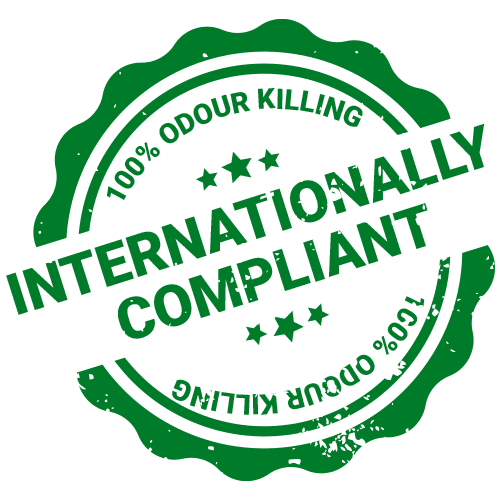- Your cart is empty
- Continue shopping
Imagine yourself walking through the streets of yellow in the summer-spring light filming the beautiful shadow of the evening sun. It is the beauty of the season spread all around.
To your discomfort, instead of the lingering smells of yellow, you get the haunting odour from the locale.
Well, you think this to be another obvious experience from your daily stroll.
But is this odour really harmless?
What if this grows to an extent that it becomes a pathetic disease for the human body?
Odour emanates when volatile molecules, known as odorants, evaporate from substances that enter the surrounding air. Odorants are specific chemical compounds found in various substances such as food, flowers, chemicals, or living organisms, human and animal wastes.
Once in the air, odorant molecules disperse from areas of higher concentration to lower concentration through diffusion. When inhaled, the odorant molecules reach the olfactory epithelium in the nose, where specialized receptors detect them. These receptors then send signals to the brain for interpretation as different smells and odours.
Not only do these odours are detected by the brain, the molecules present in them encompass the nose for a longer time.
This odour is putrid and unbearable after a certain period. Odours do not cause direct harm to the body. However, certain odorous substances may be associated with harmful effects on health. Here are a few ways where odour proves vicious and can potentially impact the body:
- Toxic or irritating substances: Some odours are associated with the presence of toxic or irritating substances. Inhaling or being exposed to these substances in high concentrations or for prolonged periods can lead to respiratory irritation, allergies, or even more serious health issues.
- Formaldehyde: Formaldehyde is a colourless gas with a strong, pungent odour. It is found in building materials, such as pressed wood products, glues, and certain fabrics. Inhalation of formaldehyde can cause eye, nose, and throat irritation, respiratory issues, and long-term exposure has been linked to an increased risk of certain
- Ammonia: Ammonia has a strong, pungent odour and is often associated with cleaning products, fertilizers, and some industrial processes. Inhalation of high concentrations of ammonia can irritate the respiratory system, leading to coughing, throat irritation, and difficulty breathing.
- Chlorine: Chlorine is commonly associated with the strong odour of swimming pools, as it is used as a disinfectant. Inhalation of high levels of chlorine gas can cause respiratory distress, eye and throat irritation, and can be particularly harmful to individuals with pre-existing respiratory conditions.
- Hydrogen sulphide: Hydrogen sulphide has a characteristic rotten egg smell and is associated with certain industrial processes, sewage systems, and natural gas. Inhalation of hydrogen sulphide in high concentrations can cause respiratory issues, eye irritation, headaches, and even loss of consciousness.
Indoor air quality: Poor indoor air quality can be caused by odours emanating from various sources such as mould, mildew, chemicals, or volatile organic compounds (VOCs). Volatile Organic Compounds (VOCs) are chemicals that can off-gas from various sources such as paints, solvents, cleaning products, and building materials. They can contribute to indoor air pollution and may cause respiratory irritation, headaches, dizziness, or even organ damage in severe cases.
Prolonged exposure to these odours and their underlying sources may contribute to respiratory problems, allergies, headaches, or other symptoms.
- Psychological impact: Certain odours can evoke strong emotional or psychological responses, which may affect an individual’s well-being. Unpleasant odours can cause discomfort, stress, or anxiety, which may indirectly impact overall health and quality of life. Some examples of odours that can evoke strong emotional or psychological responses, potentially impacting an individual’s well-being are as follows:
- Mould and mildew: The musty smell of mould and mildew can be a common trigger for anxiety or discomfort. It can remind individuals of damp or unclean environments, and some people may have specific sensitivities or allergies to mould that can worsen their psychological response.
- Chemical odours: Strong chemical odours, such as those from cleaning products, paints, or industrial chemicals, can be overwhelming and may induce feelings of unease or concern. These odours can be associated with potential health hazards, leading to heightened stress or anxiety.
- Personal scent triggers: Our sense of smell is closely tied to memory and emotions. Certain personal scents, such as perfumes, colognes, or even the natural body odour of someone we associate with negative experiences, can evoke negative emotions, discomfort, or anxiety.
- Trauma-related odours: For individuals who have experienced traumatic events, certain odours associated with the event can act as triggers, causing anxiety, fear, or distress. These odours may be connected to a specific place, object, or experience that elicits strong emotional responses.
It’s important to note that individual experiences, personal associations, and past traumas can significantly influence how a particular odour affects someone’s emotional well-being.
- Odour-related conditions: In some cases, individuals may have specific sensitivities or disorders related to odours. Conditions such as hyperosmia (heightened sensitivity to smells) or specific phobias (like specific odour phobia) can cause distress and discomfort in response to certain odours. Hyperosmia is a primary condition that can occur as a symptom of other underlying medical conditions, such as migraines, hormonal imbalances, certain neurological disorders, or even pregnancy. It is important for individuals with hyperosmia to consult with a healthcare professional for proper diagnosis and to explore strategies for managing their sensitivity to odours, as it can significantly impact their quality of life.
Odour Phobias on the other hand, also known as specific odour phobia or olfactory reference syndrome, is an anxiety disorder characterised by an intense and irrational fear or aversion to specific odours. Individuals with odour phobia experience extreme distress and anxiety when exposed to or even thinking about the particular odour that triggers their phobia.
Treatment for odour phobia may involve a combination of therapies, including cognitive-behavioural therapy (CBT), exposure therapy, and, in some cases, medication. These interventions aim to help individuals challenge their fears, manage anxiety, and gradually expose themselves to the triggering odour in a controlled and supportive environment.
It’s important to note that odour phobia is a specific anxiety disorder and should be diagnosed and treated by a qualified mental health professional.
Over the past decades, the treatment of odours has undergone a significant transformation. In the past, it was often seen as a trivial matter, but as time has progressed, it has become increasingly evident that a more comprehensive and attentive approach is necessary.
However, despite this recognition, the question of how to effectively reduce the impacts of various harmful odours remains unanswered and stagnant. Moreover, previous attempts taken while dealing with odours were merely superficial, as we were simply masking the odours rather than truly eliminating them.
This revelation can be attributed, in part, to the widespread popularity and success of scented air fresheners, which not only concealed the presence of odours but also obfuscated the underlying concept of odour elimination. This creates an urgent need for a permanent solution that addresses the complete removal of odours rather than temporary mitigation.
Well, much before that, let us understand the difference between the concept of odour-masking and odour-killing.
Odour masking involves using fragrances or scents to cover up or temporarily hide unpleasant odours without addressing the underlying cause. It does not eliminate the odour molecules but rather masks them with more pleasant smells, providing a temporary sense of freshness. However, once the masking agent dissipates, the original odour may resurface.
On the other hand, odour killing aims to eliminate odours at their source by targeting and neutralizing the odour-causing molecules. This approach involves using techniques such as molecular encapsulation, oxidation, or microbial degradation to break down or chemically alter the odour molecules, effectively eliminating them. Odour killing provides a more permanent solution as it directly tackles the root cause of the odour, rather than just covering it up temporarily.
Overall, odour masking involves temporarily hiding odours with pleasant fragrances, while odour killing involves eliminating odours at their source by targeting and neutralizing the odour-causing molecules for a more permanent solution.
The permanent solution was still a myth just before Leocym came into the picture. Leocym – The French Odour Neutralizing is prominent in removing the odour completely.
Unlike conventional air fresheners that merely mask odours, Leocym tackles the root cause by effectively neutralizing the odour molecules. Through advanced formulations and innovative techniques, Leocym ensures that the air is not only temporarily refreshed but genuinely purified, leaving no traces of lingering odours. This distinguishing feature sets Leocym apart and solidifies its position as a leading brand in odour elimination.
Under Leocym, an array of products are offered that encompass an assortment of products such as Leocym CarFresh, Leocym AeroFresh, Meat OdrKill, Fish OdrKill, Smoke OdrKill, Urine OdrKill, OdoClr and Leocym CarpCare, providing targeted solutions for specific areas. Whether rejuvenating the smell of rooms, kitchens, washrooms, urinals or revitalising fabrics and banishing unpleasant odours from cars, Leocym encompasses a comprehensive range that addresses all these requirements.
Leocym has successfully fostered awareness regarding the significance of odour elimination rather than mere masking. By actively promoting the concept of eradicating odours at their source, Leocym has educated consumers about the inherent benefits of cultivating a clean and refreshing environment. Leocym has emphasized the vital importance of neutralizing odours effectively to create a healthy and pleasant living or working space.
Through its unwavering commitment to quality, continuous innovation, and adherence to eco-friendly practices, Leocym has earned a reputable standing as a trusted brand in the realm of odour neutralizers. The incorporation of French luxury branding has elevated the perception of odour elimination, infusing a sense of sophistication and elegance into the process. By offering effective solutions that deliver long-lasting freshness and leave a lasting impression on users, Leocym has successfully fostered awareness and cultivated a preference for odour killing over odour masking.
In conclusion, the understanding and treatment of odours have evolved significantly over the past decades. The distinction between odour masking and odour killing has become crucial in addressing the impact of harmful odours. While masking provides temporary relief by covering up odours, killing odour molecules at their source offers a more permanent solution.
Leocym, a renowned French Odour Neutralizing brand, has played a pivotal role in promoting the concept of odour elimination and providing effective products that truly remove odours. By prioritising quality, innovation, and eco-friendly practices, Leocym has revolutionised the approach to odour treatment and created a healthier, more pleasant environment for all.




